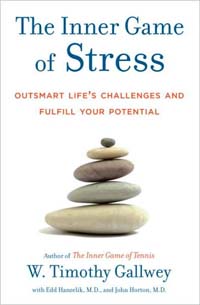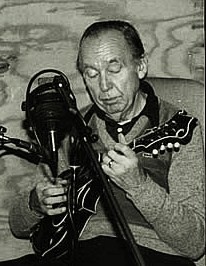« October 2009 |
Main
| December 2009 »
 November 26, 2009 | The Inner Game of Stress
November 26, 2009 | The Inner Game of Stress
Almost three years ago, we reviewed some valuable concepts introduced in a ground-breaking book, "The Inner Game of Tennis." We advocated this 1970's (revised in 1997) revolutionary approach to sports behavioral science bore relevant, credible comparisons to performing music and pointed out three strong concepts relevant to playing mandolin, including guides for experiential self-discovery, the correct way to avoid bad habits, and the significance of "interest" in effective learning. (For more detail see archive links at the bottom of the page.) The author has since authored books on the subject of golf, music, and work.
Timothy Gallwey, along with co-authors Dr. Edd Hanzelik and Dr. John Horton has just released an excellent and timely book, "The Inner Game of Stress." What does this have to do with playing? Everything, if you are all about improvement and achieving your full potential.
At best, stress can be a tremendous distraction, and at worst a crippling, life-threatening condition. It can have adverse effects on health, most definitely thwarts forward motion and progress in practice and performance. The book outlines some of the basic physiological elements in the "Game" of stress in Part 1, and offers helpful ways of "outsmarting" it in Part 2. The 3rd outlines practical and beneficial tools in conquering the condition.
A players, we are vulnerable to the often debilitating impact of stress when we tackle challenges in performing, say at a concert or exposure at a jam. The primal "fight or flight" instinct is a more immediate example of this disconnect, and this was well-covered in his earlier "Tennis" book. What Gallwey explores here is even deeper, elements of health and well-being, but issues tackled in this release are relevant to your daily practice and enjoyment of learning the mandolin. He takes a three-pronged approached, the three elements of achievement, the PLE triangle of Performance, Learning, and Enjoyment.
Performance: The most basic component in the act of achievement is our goal of excellence. We want to accomplish at a high level, but sinking all our efforts into this alone can lead us into the disastrous effects of failure, or more often, stifling fear of failure.
Learning: No matter what we do, we should always include in our activities the goal of gathering a new experience or skill. You can enter a picking contest or tackle a difficult solo knowing full well you aren't going to come out on top, but you'll write off any results as a learning experience. Challenging situations always offer some kind of learning, and if you include this as a part of the mission, it takes the pressure off performing at anything but perfection. Its knowledge also prepares you for a better follow-up attempt.
Enjoyment: Who says you have to be great at something to enjoy it? We don't all have to be Tiger Woods to look forward to golfing; we don't have to be Chris Thile in playing mandolin. Our audiences don't expect it, so why should we expect it of ourselves? If we tackle a challenge with the notion that no matter the outcome, the experience will be something that includes pleasure, the anxiety of performance becomes far less intense. Why do we call it "playing," anyway?
Obviously the PLE model is applicable to how we approach our musical performance on stage and personal practice, but these ideas are a possible realignment of how we handle stress at work and home. We want to do well, but are we learning something? Is there and element of fun in the activity? If the latter two are missing, we are completely vulnerable to the negative impacts of stress.
The 209 pages are a relatively quick read, pleasantly anecdotal and easy to digest. We highly recommend this book to anyone vulnerable to stress.
Who isn't?
Purchase information: The Inner Game of Stress

Further:
Inner Game of Tennis
Breathing through your eyes
How do I hold it?...
Picks and Doorknobs
Posted by Ted at 7:30 AM
 November 19, 2009 | Tonal Centers: a hand up from Ralph Patt
November 19, 2009 | Tonal Centers: a hand up from Ralph Patt
Almost six years ago we wrote a MandolinSessions article on Tonal Centers. (It's also a chapter of the "Getting Into Jazz Mandolin" book as well.) For one to begin to understand jazz or analyze classical music, one must be able to comprehend the mechanics of the Tonal Universe and its impact on chord functions and temporary key changes or "Micro Tonal Centers."

In reviewing the article Understanding the 'ii V7 I': Tonal Micro-centers, you'll note we explored momentary key changes and how they were set up and established with "V7 I" or some variation of 'ii V7 I' in sections. Don't worry about getting too technical for now, the main thing you need to do is "hear" the implied key changes or at least be able to section off the chords that prepare and land in different keys.
This is a great skill to have in improvising, as well as a deeper understanding of harmonic direction and chord substitution. We've enjoyed an additional online resource mentioned before, Ralph Patt's Jazz Web Page. Besides a hefty library of 400+ jazz standard chords, his " Vanilla Book," he's taken on a systematic listing of these familiar tunes and a catalog of Tonal Center "shift" maps. Not just the changes themselves, he's analyzed how some of these routine changes are stated and commonly transposed, a veritable macro map of implied Micro Tonal Centers, highlighting them in yellow.
Take some time to look at these and their links to the songs of the Vanilla Book. It will give you terrific insights into other songs you are trying to internalize and develop, and help make the large world of jazz analysis much smaller.
Enjoy: Ralph Patt Tonal Centers
Further:
Understanding the 'ii V7 I': Tonal Micro-centers
Again the Tonal Centers: Understanding the 'ii V7 I'
Fresh Comp'n Part 2: 'ii V7'
JazzMando Webtracks
Posted by Ted at 5:52 AM
 November 12, 2009 | Sharpening learning skills
November 12, 2009 | Sharpening learning skills
The young toddlers were just starting to get the hang of their early language skills. Rudimentary sentences had just grown out of new syllables and words as they were cataloging the phrases necessary to request their basic needs in food, comfort, and social affirmation. When baby Erica was picked up by her parents from day care, it was amusing to hear the choruses of what was initially observed as nonsensical phrases.
"Bee yah!" the diapered club would pepper with glee at the first glance of a Mom or Dad.
It wasn't until a few weeks after that, the parents figured out what the kids thought they were doing were repeating the word, "Yipee!" They simply had the syllables in reverse order. What's astonishing about this phenomenon is the great insight into the human brain and how rudimentary sensory information is absorbed. They were intellectualizing the very last sound they heard first, "Bee" instead of "Yip."
Think of a very difficult phrase in a song, and what it takes to learn it. Say there are sixteen notes in a complex sequence you need to master. Most will at best slow it down to absorb, some will simply repeat it over and over until down pat. The problem, the latter inefficiently takes too much time and is rarely absorbed long term. The former, slowing it down, slightly alters motion of pick and fingers and though you may get the notes, loses the technical context of proper speed.
The best approach is to dissect the phrase in segments, and start with the last segment (say 3-4 notes) first. Get it down and proceed to the next to the last segment and splice it to the last. When you have both down, move to the third to the last and proceed (better, precede...) this way until you've mastered the whole phrase. Like the toddlers, your brain needs to master the end, plant it into the subconscious before retaining a thorough understanding.
The best musicians are capable of thinking in advance of where they playing are at the moment, and this sort of learning allows you to perform in a manner of consistent "mastery" through the music, easy sections and hard sections. Woodshedding the challenging parts gives you the finesse and ability to enjoy the moment as you play.
For an example of how this might work, check out our archive article, a vivisection of the Sonny Rollins Bebop standard "Oleo." The Regressive Method (Learning it backwards...)

Regress... And move forward!
Further:
http://jazzmando.com/improvisation_pattern_based_vs_theory_based.shtml
Fingers, Ears, Brain
Dr. Mao: Four Exercises to Sharpen Your Brain
Don Stiernberg on Mindful Noodling
Posted by Ted at 1:09 PM
 November 5, 2009 | You may quote me on that
November 5, 2009 | You may quote me on that
 As a sort of private joke, our band use to enjoy slipping a favorite musical "quote" in improvising, the first eight notes of the "Theme from the Lucy Show." It took some skill to slip it in randomly throughout the evening, making the notes fit within the changing harmonic context, and it was always funnier if it got by the audience, except for a few discriminating ears. Once in a while you'd hear a snicker from one of the tables; a player is always appreciative knowing that they were listening closely. As a sort of private joke, our band use to enjoy slipping a favorite musical "quote" in improvising, the first eight notes of the "Theme from the Lucy Show." It took some skill to slip it in randomly throughout the evening, making the notes fit within the changing harmonic context, and it was always funnier if it got by the audience, except for a few discriminating ears. Once in a while you'd hear a snicker from one of the tables; a player is always appreciative knowing that they were listening closely.
This is more than just some kind of musical prank, however. Certainly, you have notable mando-jokesters like Jethro Burns and Don Stiernberg who have taken the "quoting" to a whole new level of art, and they are a joy to catch in action. Appreciate the compositional skill it takes to do this, but also recognize this is something you can translate into your own melodic creation. You don't always have to play these recognizable nuggets, like segments from the "Andy Griffith Theme," phrases from your favorite college fight song, or the beginning measures from "Scrapple from the Apple," and play them intact. You can take these recognizable motives and develop them, a miniature "theme and variation," if you will. Add some additional passing tones, adjust a note or two, make major into minor and vice versa, and you on your way to creating a totally new melody.
Licks and riffs can be tremendous jumping off points for new musical frontiers.
Of course, a little musical "Where's Waldo?" can be fun, too!
Further:
Improvisation: Pattern Based vs. Theory Based
Improvising: Throwing mud on the wall
Playing musically: Part 2, play the chords
Need a chord?
Improvising: A three-pronged attack
Posted by Ted at 1:37 PM

Disclaimer: In the 'Information Age' of the 21st Century,
any fool with a computer, a modem, and an idea can
become a self-professed 'expert." This site does not
come equipped with 'discernment.'
|



